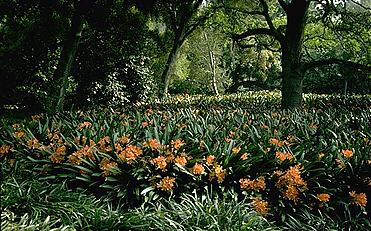|
|
  |
Home > Products > Bulbs > Clivia
| |

Clivia at the Huntington Botanic Garden |
| |
|
From South Africa comes Clivia, a genus of durable shade plants in the Amaryllis family (Amaryllidaceae). Although there are 4 species in the genus, it is the Clivia miniata that is most commonly found in cultivation in the United States. Clivia miniata is found in nature in moist and shady sites in
Natal, South Africa. This evergreen herbaceous plant typically has a large head (umbel) of between 12 and 20 orange-red trumpet shaped flowers. The leaf width and flower color of Clivia miniata is variable and many selections have been made and named. There are many people currently interested in Clivia and Clivia breeding. At the 2001 Clivia Symposium, held at the Huntington Botanic Garden many people from around the world gathered to discuss and share information on Clivia. In 2002 Harold Koopowitz's excellent book Clivias was published by Timber Press. This is a great book! It is the first to detail the members of the genus Clivia. Beginning with the story of their discovery then on to issues of cultivation, hybridization, and propagation. The information in this book is great and it is beautifully illustrated. To Purchase this book online. Also check out the article "Clivia in California" by Randy Baldwin in the Winter 2004 Issue of The Nursery Pro. A publication of the California Association of Nurseries and Garden Centers (CANGC), the The Nursery Pro is published quarterly and is distributed to certified Califorinia nursery professionals.
Clivia Culture
Clivias are best suited to a shaded location in a
fairly frost free garden. They thrive in situations with
regular irrigation as well as ones that are only watered infrequently. Clivia is tolerant of winter temperatures into the low 20°'s and winter moisture as long as the soil drains. In colder climates plants can be brought in until the danger of frost is past. Flowering typically commences in mid to late winter and continues through early spring. After flowering plants can produce showy fruit which often is the same color as the flowers - red or yellow.
San Marcos Growers currently is growing the following selections:
Clivia caulescens
This plant has spreading, floppy leaves and produces flower heads smaller than in C. miniata with pendant, funnel-shaped, pale red flowers with yellow stamens. It typically grows to about 2 to 3 feet tal. It is different than all the other Clivias, because of the thick stalk, up to 3+ft long that terminates with leaves at top giving this plant the common name Stalked Clivia. As with other Clivia, C. caulescens prefers and prefers light shade, fairly frost free conditions and dislikes water logged soils. It is native to the eastern Transvaal in South Africa, and to Swaziland. Our plants are grown from seed from Silverhill Seeds in South Africa.
Clivia miniata
These plants are typical of the native plants found in South Africa. They have thin (1 to 1/1/2 inch wide) leaves and pale orange flowers. Less often sold in nurseries than wider leafed cultivars but commonly shared between gardeners. We grow it because of its neat narrow leaves and pale flowers look great in mass plantings. A very drought resistant plant for under Oak Trees in coastal California.
Clivia miniata "French Hybrids"
Evergreen strap leafed plant with late winter and early spring-blooming dark orange flowers on fleshy, rigid stems to 24" that rise from clumps of dark green, wide leaves. Plant in light shade and give it regular watering. Needs a nearly frostless climate if grown outdoors. It grows to about 2 feet by 2 feet eventually. It is hardy to climates that may have a winter chill down into high 20 degrees F for short durations. Beautiful as an individual specimen in the ground or in pots or in mass plantings. These plants are from a seed strain that has predominately wider leaves and darker orange-red flowers. Often times called or confused with Belgium Hybrids which are also wide leafed. The differences between these two groups of plants are minor although it is our thought that the French hybrids have longer leaves.
Clivia miniata 'San Marcos Yellow' (Clivia miniata var. citrina) - Yellow Clivia
Found in 1888 in the forests around Eshowe in Zululand, this nearly fabled Clivia selection is still as rare and expensive as it is beautiful. Clear yellow flowers in large rounded heads stand high above the dark green 2 inch wide foliage. San Marcos Growers introduced its Yellow Clivia line in 1993 under the name Clivia miniata 'Aurea'. After discussions with other Clivia breeders we have decided to call the seed strain Clivia miniata 'San Marcos Yellow'. We have steadily worked at producing larger quantities to satisfy the demand for this gem of a plant. Visit our Yellow Clivia page for more information.
Clivia nobilis
This 1-2 foot tall plant forms clumps of strap-shaped, dark green leaves with slightlty serrated edges and a rounded tip. It produces long-blooming, tubular orange flowers that droop. It enjoys bright shade or morning sun, regular irrigation and winter temperatures not much below freezing. Was the first Clivia to be described.
What's in a name: The name Clivia was given
to this ornamental genus of plants by John Lindley (1799-1865) to
compliment Lady Clive, the Duchess of Northumberland. By the
rules of nomenclature the pronunciation of Clivia should be
pronounced with a long
"í" (Clí-via)
following the name Clive which it commemorates.
Check Out the happenings at the 2001 Clivia
Symposium
|
|
|

